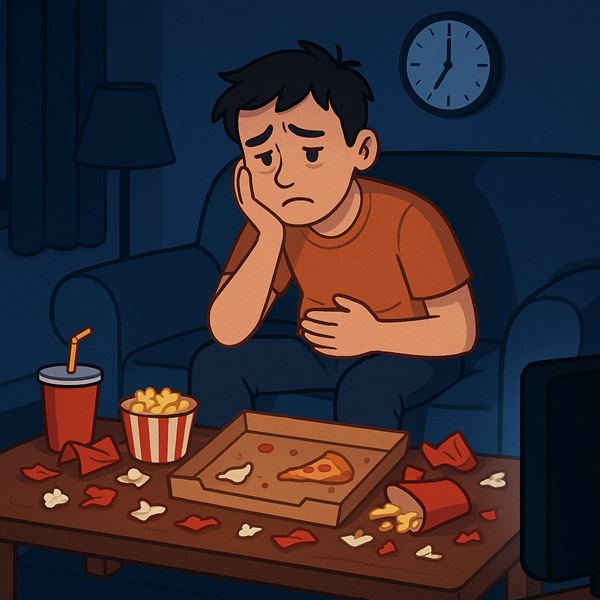Dealing with False Hunger: 3 Common Types of Emotional Eating You Should Know
Are you eating less but still not seeing results in your weight loss journey? You might be unknowingly falling into the trap of false hunger—a pattern of eating not driven by physical need but by your emotional state. I know this because I’ve been there myself, thinking I was eating light, only to realize I was caught in mindless emotional eating habits that sabotaged all my progress.
Simply put, emotional eating is when we eat not to satisfy hunger but to feel better. Whether it’s a sweet treat after a stressful day or grabbing snacks at night out of boredom, these behaviors are incredibly common, especially among people facing emotional turbulence—both big and small.
Food companies know this well. That’s why they market products with feel-good messaging, reinforcing the idea that food equals happiness. But when we consistently use food to cope with emotions like stress, anger, loneliness, or anxiety, it becomes a serious concern—one that can lead to weight gain, poor health, and emotional dependence on food.
If you’re able to recognize that your hunger may be emotionally driven, consider yourself fortunate. Most people don’t even realize they’re eating to fill an emotional void. Emotional eating can take many forms—like snacking after meals, eating out of boredom, indulging in sweets late at night, or always needing something to munch on while watching TV.
Occasionally enjoying food for comfort is perfectly okay, but when this becomes your regular coping mechanism, it’s time to break the cycle. The more we try to “feed” an emotion, the more disconnected we become from our body’s real needs—and our health suffers silently.
In this post, we’ll take a deep look into the three most common types of emotional eating: midnight cravings, sugar/chocolate cravings, and mindless multitasking munching. You’ll also learn how to recognize these patterns and apply effective, mindful strategies to overcome them. If you’re serious about losing weight or regaining control over your health, identifying and dealing with false hunger is a game-changer.
#1 How to Stop Nighttime Eating: Breaking the Habit of Late-Night Cravings
One of the most common—and often overlooked—types of emotional eating is nighttime binge eating. You might think you eat less during the day, but unknowingly you may be falling into a pattern of mindless eating at night, especially while watching TV or working late. I know this because I’ve been there. Emotional hunger can disguise itself as real hunger and sabotage all your weight loss efforts if not addressed properly.
This habit is often linked to what’s known as Night Eating Syndrome (NES), where a person feels compelled to eat after dinner, sometimes even waking up in the middle of the night to snack. Though it may feel comforting in the moment, this habit can harm both your physical and emotional health. In fact, studies show that irregular eating patterns and skipped meals during the day can disrupt metabolism, increase emotional stress, and impact sleep.
Below are some practical and mindful ways to manage and eventually stop nighttime eating:
- Eat Properly During the Day: Don’t skip meals. Restrictive eating can cause rebound hunger at night. Make breakfast and lunch a priority to avoid this cycle.
- Pause Before You Eat: When the urge hits, stop and reflect. Are you truly hungry, or just bored, stressed, or tired? Give your mind a chance to reset before reaching for food.
- Go to Bed Earlier: Staying up late increases the likelihood of snacking. Try to establish a regular sleep schedule and avoid late-night distractions.
- Practice Mindful Eating: Be present with your meals—savor the taste, texture, and smell. This mindfulness eating script can help you get started.
- Address Your Emotions: Emotional imbalances like stress, anxiety, or sadness often manifest as food cravings. Nighttime can intensify these emotions, making food seem like the only comfort. Try journaling, meditating, or seeking support.
- Break Emotional Patterns: If you associate nighttime with emotional relief, try replacing that habit with something healthier—like relaxing music, reading, or gentle yoga.
- Identify and Avoid Triggers: Watching TV or scrolling your phone may be linked to your cravings. Be aware of these patterns and make a conscious effort to disconnect.
With awareness and the right approach, you can break free from nighttime emotional eating and cultivate a healthier, more intentional relationship with food. Start by identifying your triggers and practicing more presence during meals—you’ll notice the change.
#2 How to Stop Craving Chocolate and Sugary Foods When You’re Not Physically Hungry
Craving chocolate or sugary snacks when you’re not physically hungry is a classic sign of false hunger. Whether it’s the sweet aftertaste, the “comfort” effect, or simply the habit, many people find themselves turning to sugar even when their body doesn’t truly need food. While occasional indulgence is fine, habitual consumption of high-sugar items like chocolate can quickly spiral into emotional eating and lead to both mental and physical health issues.
Chocolate, in particular, activates “feel-good” chemicals like dopamine in the brain, which is why it becomes so addictive. A few bites can easily turn into a full bar, especially during moments of emotional vulnerability. In fact, people recovering from breakups or going through emotional pain often use chocolate as a form of escape. Over time, this coping mechanism can result in weight gain and deeper health problems. You can learn more about this pattern in our post on healing from toxic emotional experiences.
The good news is that with mindful awareness of your triggers, you can gradually reduce your dependency on sweets and develop a more balanced relationship with food.
Why You Crave Chocolate and Sugary Foods—and How to Stop It Mindfully
Eating a small piece of chocolate or a sugary treat once in a while isn’t harmful—in fact, some studies even show that moderate chocolate consumption can have health benefits. However, the problem arises when a little treat becomes a regular habit, especially when you’re not physically hungry. Many people struggle with chocolate cravings or cravings for sugary foods that show up as emotional hunger, often during stress, boredom, or emotional lows.
Chocolate is particularly addictive because it stimulates the release of chemicals like dopamine and serotonin in the brain, giving you an instant “feel-good” response. This is why it’s so hard to stop after just one bite. Unfortunately, this quick fix for emotional discomfort often leads to excessive calorie intake, weight gain, and feelings of guilt, especially when it becomes a pattern.
These cravings are often linked to unresolved emotional triggers. For example, people going through emotional distress such as heartbreak often turn to chocolate as a source of comfort. But this temporary relief can easily snowball into unhealthy eating patterns. If this resonates with you, it may be helpful to explore my post on how to deal with emotional pain caused by toxic relationships.
Whether it’s late-night snacking or frequent chocolate binges during the day, overcoming the habit of eating sugary food when you’re not truly hungry requires awareness and a few mindful shifts in your approach. Here are several strategies that can help:
1. Gradually Shift Your Chocolate Preferences
Quitting chocolate or sugar entirely using willpower alone can backfire. It often leads to withdrawal-like symptoms such as headaches, frustration, or irritability. A more effective approach is to gradually reduce your dependence by trying different types of chocolates—especially dark chocolate or low-sugar varieties—rather than eating the same high-sugar kind repeatedly. This can reduce the habitual nature of your cravings and help ease you into more mindful choices.
2. Stop Keeping Chocolate and Sweets at Home
It might sound contradictory, but after experimenting with different chocolate types and gaining some level of control, the next step is to stop keeping sugary snacks at home altogether. When these foods are easily accessible, the likelihood of impulsive emotional eating increases. If you must have chocolate, make it a deliberate act—walk to the store and buy just one small bar. The added effort serves as a deterrent and helps break the automatic pattern of reaching into your fridge for sugar every time a craving strikes.
3. Identify the Real Reason Behind the Craving
There was a time when I used to grab a chocolate bar around noon just to pair it with my favorite TV show. But when that routine changed, the cravings disappeared too. I later realized I wasn’t truly hungry—I was just bored and looking for comfort. That’s why it’s crucial to identify what emotional need you’re trying to satisfy. Often, sugar cravings arise during low-energy moments or as a way to escape emotional discomfort. For many, sugary foods like chocolate serve as emotional band-aids.
The deeper the emotional connection to food, the more challenging the habit becomes. But the good news is that you can use your cravings as opportunities to practice mindfulness. Simply observing your thoughts and emotional state in the moment can help you make better choices.
4. Replace Chocolate with Other (Non-Sugary) Options
While replacing one craving with another food isn’t a long-term solution, it can be a temporary strategy. Keep some healthy snacks at home that you enjoy (but that aren’t sugary), like fruits, nuts, or a warm herbal tea. When the urge for chocolate strikes, reach for these alternatives instead. It might not feel satisfying at first, but over time, your brain will begin to shift its associations.
Just remember—don’t let this turn into another unconscious habit. Emotional eating patterns can transfer from one food item to another if the root emotional causes aren’t addressed.
5. Don’t Demonize Chocolate or Sugar
A common trap people fall into is blaming chocolate for their lack of control. Labeling sweets as “bad” or “the enemy” only creates more inner conflict, which can feed the cycle of craving and guilt. Instead, try to cultivate peace with your cravings. See them as signals, not enemies. Self-criticism and guilt only make the cravings stronger.
Accept your cravings with compassion. When you do that, it becomes easier to respond with mindfulness rather than react impulsively. A regular mindfulness meditation practice can be incredibly helpful in cultivating this level of emotional balance.
6. Find Better Ways to Feel Good
Emotional eating often happens because we’re simply trying to feel better. Whether it’s boredom, loneliness, sadness, or anxiety, the craving for chocolate or sugar is usually about escaping discomfort. So instead of resisting the craving with force, ask: “What would genuinely make me feel good right now?”
It could be stepping outside for a mindful walk, calling a friend, listening to your favorite music, or journaling. These are simple activities that can replace the temporary comfort of sugar with something more fulfilling. And most importantly, they help you get in touch with what your mind and body actually need.
In the end, learning to stop eating sugary foods when you’re not hungry isn’t just about control—it’s about connection. Connection to your body, to your emotions, and to your moment-to-moment experience. When you begin to recognize false hunger for what it truly is, you naturally make better choices.
#3 How to Stop Mindless Munching While Multitasking and Start Eating with Awareness
Ever found yourself finishing an entire bowl of snacks without even realizing it while watching a movie or working on your laptop? You’re not alone. Many people have developed a habit of multitasking while eating—watching TV, scrolling through their phone, or even working. Some are so used to eating with their mind preoccupied that they feel uncomfortable eating in silence. This pattern of mindless multitasking munching is one of the major causes of overeating and poor food choices.
When you’re distracted, your brain doesn’t register how much you’ve eaten, and you miss the signals your body sends when it’s full.
This results in not only overeating but also ignoring your body’s actual needs. While you might carefully count calories during meals, snacks often slip under the radar.
Those handfuls of chips or chocolates while watching sports or answering emails can quietly contribute to unhealthy weight gain and other health issues.
Here are a few ways to break free from this autopilot behavior and start eating with awareness:
- Eat only when you’re genuinely hungry: Emotional hunger feels urgent and specific—like a sudden craving for sweets. True hunger, however, builds gradually. Learning to distinguish between the two can stop binge cycles before they start.
- Be present while eating: Focus on the aroma, texture, and taste of your food. This simple act of mindfulness while eating helps shift your attention from emotional impulses to actual nourishment, and it allows you to enjoy your meals more deeply.
- Practice Meditation: Setting a few minutes from your time to practice a simple meditation to clear your mind will help you to be more present and implement mindfulness about which I talked in the above point.
- Accept your emotions: Using food to escape uncomfortable feelings only masks the real issue. Instead, sit with your emotions without judgment. Often, just allowing yourself to feel what you’re feeling is enough to let it pass naturally.
- Discover alternative joys: Next time you feel like munching, pause and check in with your emotions. Are you bored, stressed, or lonely? Try uplifting alternatives like listening to music, taking a short walk, or watching something inspiring.
- Get proper rest: Lack of sleep disrupts hunger hormones and triggers cravings. A restful night not only resets your body but also gives your mind the clarity to make better food choices.
- Plan your day intentionally: A well-structured day naturally reduces emotional eating. In fact, I found that having a plan—like I shared in my Law of Attraction journey—made a big difference in my eating habits and overall well-being.
It’s important to be aware of how our mind tricks us into eating when we aren’t truly hungry. Once we start practicing mindful eating, we can better recognize our body’s needs, enjoy our food more, and make healthier choices overall.
Frequently Asked Questions
What is false hunger and how can I identify it?
False hunger often feels sudden and intense, usually triggered by emotions or habits rather than actual nutritional need. Unlike real hunger, which builds gradually, false hunger makes you crave specific comfort foods like chocolate or sugary snacks. Recognizing this can help you break the cycle of emotional eating.
Why do I crave chocolate when I’m feeling low or going through emotional stress?
Craving chocolate during emotional stress is common because it releases “feel-good” chemicals like serotonin. This often becomes a coping mechanism for those dealing with breakups or toxic relationships. Read more about healing emotional pain to address the root cause of such cravings.
How can I stop eating chocolate and sugary snacks every day?
A gradual approach works best. Start by introducing different types of chocolate to prevent habitual triggers, then slowly reduce availability at home. Replace the habit with healthier alternatives and practice mindful eating to become more aware of your cravings and choices.
Why do I eat more when I’m watching TV or working?
Eating while multitasking — like watching movies or working — distracts your mind from recognizing satiety signals. This mindless munching leads to overeating and unhealthy food choices. Practicing mind-clearing techniques can help bring awareness back to your meals.
Can emotional eating affect my physical health even if I eat small meals?
Yes. Many people count calories only during main meals but consume snacks and sugary foods mindlessly throughout the day. These hidden calories can lead to weight gain and health issues. Creating a structured daily plan, can prevent emotional snacking patterns.
What is the role of mindfulness in overcoming sugar cravings?
Mindfulness helps you become aware of your emotional state and eating patterns. By being present while eating, you can enjoy food more and detect whether you’re truly hungry or just feeding an emotional need. Learn more about the benefits of mindfulness in overcoming emotional eating.
Ready to Take Control of Your Eating Habits?
If this post helped you better understand false hunger, emotional eating, or sugar cravings, I’d truly love to hear your thoughts. Share your experience or ask questions in the comments — your voice matters and your story could inspire others.
If you’re looking for deeper support or long-term transformation, don’t miss my journey: How I used the Law of Attraction to lose weight.
For those ready for a more structured, lasting shift in their relationship with food, I highly recommend Mindvalley’s WildFit program by Eric Edmeades. It’s a game-changer — practical, powerful, and mindset-based.
Got questions about mindset, cravings, or emotional eating? Drop them in the comments or reach out through my Contact Page — I’m here to support you.
If this post resonated with you, please share it with someone who might benefit. Let’s help more people eat mindfully and live consciously!!
